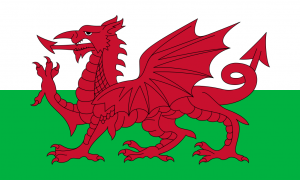Language/Welsh/Vocabulary/Geography
Hi Welsh learners! 😊
In this lesson, you will learn important Welsh vocabulary related to geography. We will also include cultural information and interesting facts to make your learning experience more enjoyable. So, let's dive in!
Consider broadening your understanding by checking out these related lessons: Seasons & Greetings.
Welsh Vocabulary[edit | edit source]
To start, let's begin with some basic Welsh vocabulary.
| Welsh | Pronunciation | English |
|---|---|---|
| Proffil tirwedd | proh-fil ti-rwehd | Landscape profile |
| Daearyddiaeth | dah-eh-ree-thy-eth | Geography |
| Y graig | uh graig | The rock |
| Y bont | uh bont | The bridge |
| Y môr | uh mohr | The sea |
| Y mynydd | uh mun-uth | The mountain |
Cultural Information[edit | edit source]
Wales is known for its natural beauty, including its stunning coastline, hills, mountains, and valleys. The Snowdonia National Park, located in the northwest of Wales, has the highest mountain in England and Wales, Mount Snowdon (Yr Wyddfa), which stands at 1,085 meters (3,560 feet) above sea level. It attracts hundreds of thousands of visitors every year who come to enjoy its vast landscapes, including breathtaking waterfalls and scenic routes.
Another iconic landmark of Wales is the Pontcysyllte Aqueduct. Built-in 1805 by Thomas Telford, it is the longest and highest aqueduct in Britain, spanning over 1,000 feet (305 m) and towering 126 feet (38 m) above the River Dee.
Interesting facts[edit | edit source]
Did you know that the Welsh language has over 30 words for different types of rain? These include toredig (drizzling), glaw hoyw (heavy rain), and tawelbwrw (light shower), cf. the Welsh vocabulary lesson Weather.
In Wales, the largest town is called Llanelli, located in the southwest of the country. It has a population of around 50,000 people and is famous for its rugby team, the Scarlets.
Another interesting fact is that Wales has its own unique musical instrument called the triple harp. It has three rows of strings and is played differently compared to the traditional harp, which has only one row of strings.
Dialogue[edit | edit source]
Let's practice using some of the vocabulary we learned in a dialogue:
- Person 1: Rydw i'n hoffi mynd i'r mynyddoedd. (I like to go to the mountains.)
- Person 2: Pam? Mae'r bont dros y bryn yn llawer mwy prydferth. (Why? The bridge over the hill is much more beautiful.)
- Person 1: Dw i wedi bod i'r bont yn barod. (I have already been to the bridge.)
- Person 2: Felly, dylech chi weld y graig. (Then, you should see the rock.)
Practice Makes Perfect[edit | edit source]
Now it's time to practice. Use Find native speakers and ask them any questions you may have. You can also check out our Vocabulary page for more words to improve your Welsh language skills.
Conclusion[edit | edit source]
That's all for now! We hope you enjoyed learning important Welsh vocabulary related to geography, as well as some cultural information and interesting facts. Don't forget to use the hyperlinks we provided throughout the lesson, such as Polyglot Club to enhance your language learning experience. Diolch! (Thank you!)
➡ If you have any questions, please ask them in the comments section below.
➡ Feel free to edit this wiki page if you think it can be improved. 😎
Finished this lesson? Check out these related lessons: Education & Love.
Other Lessons[edit | edit source]
- Family
- Health
- Qualities
- Fruits
- Animals
- Count to 10
- Drinks
- How to say Good Bye?
- Education
- Basic phrases
Sources[edit | edit source]
- Place and identity: Wales, 'Welshness' and the Welsh language ...
- Welsh toponymy - Wikipedia
- Language, geography and identity: The case of the Welsh in London ...

